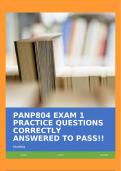PANP804 EXAM 1
PRACTICE QUESTIONS
CORRECTLY
ANSWERED TO PASS!!
PANP804
Evatee 9/2/24 PANP804
,PANP804 EXAM 1 PRACTICE (FLUID AND
ELECTROLYTES, NEPHURO/URINARY/ENDO)
QUESTIONS CORRECTLY ANSWERED TO
PASS!!
A 9-month-old is intubated and ventilated in the pediatric intensive care unit
following full cardiopulmonary arrest secondary to suspected nonaccidental
trauma. After stabilization and central line placement, she is reported to have
excessive urine output over the past 3 hours, which is calculated to be >4
mL/kg/hour. The most likely rationale and management is:
A. Syndrome of inappropriate antidiuretic hormone (SIADH); obtain a basic
metabolic panel (BMP), urinalysis, urine electrolytes, urine and serum
osmolarity.
B. Cerebral salt wasting (CSW); obtain BMP, complete blood count (CBC),
urinalysis, urine electrolytes panel, and urine osmolarity.
C. Central diabetes insipidus (DI); obtain BMP, urinalysis, urine electrolytes,
urine and serum osmolarity.
D. Increased urine output due to extensive fluid resuscitation during
stabilization period; obtain BMP in 8 hours. Answer - C. Central diabetes
insipidus (DI); obtain BMP, urinalysis, urine electrolytes, urine and serum
osmolarity.Central DI is the inability to concentrate urine secondary to a
vasopressin deficiency which can occur as a result of head trauma due to
edema in the area surrounding the hypothalamus and pituitary gland. Classic
findings of DI include excess urine output with low urine osmolarity (specific
gravity <1.005), high serum osmolarity, and hypernatremia. Polyuria can be >4
mL/kg/hour in infants and 150 mL/kg/day in older children. Direct
measurements of urine sodium excretion, in addition to serum and urine
osmolality, are critical in diagnosing DI. Laboratory studies to confirm the
diagnosis of DI and to differentiate it from cerebral salt wasting include a urine
,sodium <30 mEq/L, urine osmolarity <200 mOsm/L, serum sodium >150
mEq/L, and serum osmolarity >295 mOsm/L. DI should be identified as soon as
possible to prevent profound hypovolemic hyperosmotic dehydration. SIADH
results in decreased urine output due to an excess in antidiuretic hormone.
Pancreatitis, celiac disease, short gut syndrome, and inflammatory bowel
disease may result in which of the following alterations in serum magnesium
levels?
A. Hypomagnesemia.
B. Hypermagnesemia.
C. Severe, life-threatening hypermagnesemia.
D. No effect on serum magnesium levels. Answer - A.
HypomagnesemiaGastrointestinal losses are one of the leading causes of
hypomagnesemia in the hospitalized child.
Peaked T waves found on a pediatric EKG are typically caused by which of the
following electrolyte abnormality?
A. Hypocalcemia.
B. Hypophosphatemia.
C. Hyperkalemia.
D. Hypoglycemia. Answer - C. Hyperkalemia.Hyperkalemia typically causes
peaked T waves on EKG and is the most common presentation of this
abnormality in children. If a child has an elevated potassium level, an EKG can
support the reliability of the laboratory result. In all cases, however, the
electrolytes should be repeated
A 13-day-old female infant presents with lethargy and poor feeding. She is
hypotonic, dehydrated, and has ambiguous genitalia. Laboratory evaluation
reveals that the infant has hypoglycemia, hyponatremia, hyperkalemia with
metabolic acidosis. Which of the following is the most likely diagnosis?
A. Hyponatremia secondary to improper formula mixing.
, B. Congenital adrenal hyperplasia (CAH).
C. Acute renal failure
D. Sepsis. Answer - B. Congenital adrenal hyperplasia (CAH).
CAH is characterized by a 21-hydroxylase deficiency, which typically presents
with a salt-wasting crisis in the first few weeks of life. This enzyme deficiency
results because of insufficient adrenal production of cortisol and aldosterone,
in addition to an excess of androgens, which can also cause ambiguous
genitalia in female infants. Clinical manifestation of acute adrenal crisis in CAH
includes lethargy, poor feeding, altered sensorium, vomiting, hypotension, and
hypothermia. Laboratory findings include hypoglycemia, hyperkalemia,
hyponatremia, dehydration, and metabolic acidosis.
Secondary hypertension is typically caused by which of the following
etiologies?
A. Adrenal insufficiency.
B. Renal disease.
C. Type 2 diabetes mellitus.
D. Genetic predisposition Answer - B. Renal disease.Secondary hypertension is
more common in children than in adults and is most often caused by renal
disease. Adrenal insufficiency, certain medications (including corticosteroids),
sleep apnea, stress, and anxiety can also be causative factors. Genetic
predisposition is the most common cause of primary hypertension in children.
A 10-year-old patient is now 100 days out from a living donor liver transplant,
and presents with dysuria and fever for 2 days. A urine culture is positive for
Aspergillus. In choosing an antifungal agent, which of the following treatment
options is the most appropriate?
A. Oral fluconazole.
B. IV amphotericin B.
C. IV voriconazole.




